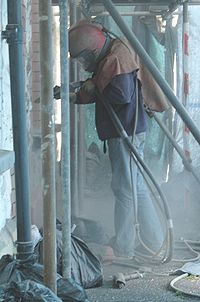
Photo from wikipedia
Utilizing solid particles as a heat-transfer medium in concentrated solar power applications has gained growing attention lately. Unlike molten salts, solid particles offer many benefits, which include: high operating temperatures… Click to show full abstract
Utilizing solid particles as a heat-transfer medium in concentrated solar power applications has gained growing attention lately. Unlike molten salts, solid particles offer many benefits, which include: high operating temperatures (greater than 1000 °C), a lack of freezing issues and corrosivity, abundant availability, high thermal energy storage capacity, a low cost, and applicability in direct irradiation. Comprehensive knowledge of thermophysical and optical properties of solid particles is essential to ensure an effective harnessing of solar energy. The most important considerations when selecting solid particles include: thermophysical and optical properties, thermal resistance, crack resistance, satisfactory health and safety risks, availability, and low cost. It is also imperative to consider optical and thermophysical characteristics that might change from what they were “as received” after cyclic heating for a long period. Therefore, the knowledge of thermal performance of particulate materials becomes significant before using them as a heat-transfer medium. In this study, some particulate materials were chosen to study their feasibilities as heat-transfer and storage media for a particle-based central receiver tower system. These particulate materials included white sand, red sand, ilmenite, and Carbobead CP. The candidate particulate materials were heated at high temperatures for 6 h and then cooled to room temperature. After that, cyclic heating was performed on the particulate materials for 500 h at 1200 °C. The optical properties were represented by weighted solar absorptance, and the thermophysical properties of the particulates were measured “as received” and after cyclic heating (aging). EDX and XRD were conducted to quantify the chemical composition and interpret the changes in appearance associated with the particulate materials after cyclic heating. The results showed a considerable agglomeration in all particulates except for white sand in the 6 h heating test, and high agglomeration in the ilmenite. A slight decrease in the optical properties in the white sand and Carbobead CP was found after the aging test. The specific heat was decreased for red and white sand. The EDX and XRD results for white sand and Carbobead CP showed chemical stability, indicating high durability and reliability.
Journal Title: Materials
Year Published: 2022
Link to full text (if available)
Share on Social Media: Sign Up to like & get
recommendations!